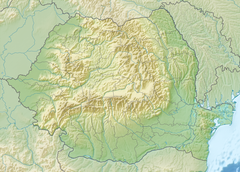Peștera cu Oase
| Peștera cu Oase | |

Oase 2 skull
|
|
| Location | near Anina city |
|---|---|
| Region | Caraș-Severin county, southwestern Romania |
| Coordinates | 45°01′N 21°50′E / 45.017°N 21.833°ECoordinates: 45°01′N 21°50′E / 45.017°N 21.833°E |
| History | |
| Periods | Paleolithic |
Peștera cu Oase (Romanian pronunciation: [ˈpeʃtera ku ˈo̯ase], meaning "The Cave with Bones") is a system of 12 karstic galleries and chambers located near the city Anina, in the Caraș-Severin county, southwestern Romania, where some of the oldest early modern human remains in Europe (37,800 years old) have been discovered.
In 2015 genetics research revealed that the Oase 1 fossil had a recent Neanderthal ancestor, with an estimated 5-11% Neanderthal autosomal DNA. The specimen's 12th chromosome was also 50% Neanderthal.
In February 2002, a speleological team exploring the karstic system of Miniș Valley, in the southwestern Carpathian Mountains near Anina, revealed a previously unknown chamber with a profusion of mammalian skeletal remains. The cave, which seemed to have served primarily as hibernation room for the cave bear (Ursus spelaeus), presented unusual arrangements such as the placement of some remains on raised rocks, suggesting a certain human involvement in the accumulated deposits. In fact, speleologists Ștefan Milota, Adrian Bîlgăr and Laurențiu Sarcina discovered a complete human mandible on the paleosurface. The karstic chamber was designated as "Peștera cu Oase" (The Cave with Bones) and the human mandible as "Oase 1".
The latest radiocarbon dates of the Oase fossils give an age of 37,800 years BP. From a location close to the Iron Gates in the Danubian corridor, they may represent one of the earliest modern human populations to have entered Europe.
In June 2003 a further research team with Ștefan Milota, Ricardo Rodrigo and Mircea Gherase discovered additional human remains on the cave's surface. Thus, an entire anterior cranial skeleton was found along with a largely complete left temporal bone and a number of frontal, parietal and occipital bone segments.
...
Wikipedia

